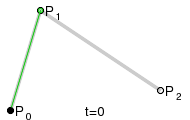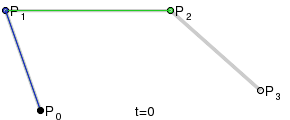如何在C ++中实现Bézier曲线?
我想实现Bézier curve。我以前在C#中做过这个,但我对C ++库完全不熟悉。我该如何创建二次曲线?
void printQuadCurve(float delta, Vector2f p0, Vector2f p1, Vector2f p2);
显然我们需要使用线性插值,但这是否存在于标准数学库中?如果没有,我在哪里可以找到它?
更新1:
抱歉,我忘了提及我正在使用Linux。
8 个答案:
答案 0 :(得分:102)
最近我遇到了同样的问题,想要自己实现。 维基百科的这张图片帮助了我:

以下代码是用C ++编写的,展示了如何计算二次贝塞尔曲线。
int getPt( int n1 , int n2 , float perc )
{
int diff = n2 - n1;
return n1 + ( diff * perc );
}
for( float i = 0 ; i < 1 ; i += 0.01 )
{
// The Green Line
xa = getPt( x1 , x2 , i );
ya = getPt( y1 , y2 , i );
xb = getPt( x2 , x3 , i );
yb = getPt( y2 , y3 , i );
// The Black Dot
x = getPt( xa , xb , i );
y = getPt( ya , yb , i );
drawPixel( x , y , COLOR_RED );
}
图像中的(x1 | y1),(x2 | y2)和(x3 | y3)是P0,P1和P2。只是为了展示基本想法...
对于那些要求立方贝塞尔的人,它只是模拟(也来自维基百科):

This回答提供了代码。
答案 1 :(得分:11)
以下是包含任意点数的曲线的一般实现。
vec2 getBezierPoint( vec2* points, int numPoints, float t ) {
vec2* tmp = new vec2[numPoints];
memcpy(tmp, points, numPoints * sizeof(vec2));
int i = numPoints - 1;
while (i > 0) {
for (int k = 0; k < i; k++)
tmp[k] = tmp[k] + t * ( tmp[k+1] - tmp[k] );
i--;
}
vec2 answer = tmp[0];
delete[] tmp;
return answer;
}
请注意,它使用堆内存作为临时数组,但效率并不高。如果您只需处理固定数量的点,则可以对numPoints值进行硬编码并改为使用堆栈内存。
当然,上面假设你有一个vec2结构和运算符,如下所示:
struct vec2 {
float x, y;
vec2(float x, float y) : x(x), y(y) {}
};
vec2 operator + (vec2 a, vec2 b) {
return vec2(a.x + b.x, a.y + b.y);
}
vec2 operator - (vec2 a, vec2 b) {
return vec2(a.x - b.x, a.y - b.y);
}
vec2 operator * (float s, vec2 a) {
return vec2(s * a.x, s * a.y);
}
答案 2 :(得分:7)
您之前是否使用过C#库?
在C ++中,Bezier曲线的标准库函数尚未可用(尚未)。您当然可以自己动手(CodeProject sample)或寻找数学库。
This blogpost在Actionscript中很好地解释了这个想法。翻译不应该是一个很大的问题。
答案 3 :(得分:7)
你可以选择de Casteljau的方法,它是递归地分割控制路径,直到你使用线性插值到达点,如上所述,或Bezier的混合方法控制点。
Bezier的方法是
p = (1-t)^3 *P0 + 3*t*(1-t)^2*P1 + 3*t^2*(1-t)*P2 + t^3*P3
表示立方体和
p = (1-t)^2 *P0 + 2*(1-t)*t*P1 + t*t*P2
用于样方。
t通常在0-1,但这不是必要的 - 实际上曲线延伸到无穷大。 P0,P1等是控制点。曲线通过两个端点,但通常不通过其他点。
答案 4 :(得分:1)
-
如果您只想显示贝塞尔曲线,可以使用类似PolyBezier的Windows。
-
如果您想自己实施例程,可以在Intarnetz上找到linear interpolation code。
-
我相信Boost libraries对此有所支持。线性插值,而不是Beziers。但是,请不要引用我的话。
答案 5 :(得分:0)
我基于这个例子 https://stackoverflow.com/a/11435243/15484522 做了一个实现,但是对于任意数量的路径点
void bezier(int [] arr, int size, int amount) {
int a[] = new int[size * 2];
for (int i = 0; i < amount; i++) {
for (int j = 0; j < size * 2; j++) a[j] = arr[j];
for (int j = (size - 1) * 2 - 1; j > 0; j -= 2)
for (int k = 0; k <= j; k++)
a[k] = a[k] + ((a[k+2] - a[k]) * i) / amount;
circle(a[0], a[1], 3); // draw a circle, in Processing
}
}
其中 arr 是点数组 {x1, y1, x2, y2, x3, y3... xn, yn},size 是点的数量(两倍小于数组大小),数量是输出点数。
为了优化计算,您可以使用 2^n 数量和位移:
void bezier(int [] arr, int size, int dense) {
int a[] = new int[size * 2];
for (int i = 0; i < (1 << dense); i++) {
for (int j = 0; j < size * 2; j++) a[j] = arr[j];
for (int j = (size - 1) * 2 - 1; j > 0; j -= 2)
for (int k = 0; k <= j; k++)
a[k] = a[k] + (((a[k+2] - a[k]) * i) >> dense);
circle(a[0], a[1], 3); // draw a circle, in Processing
}
}
答案 6 :(得分:0)
以给定的行程百分比 (x, y) 沿三次曲线获得单个点 (t),并具有给定的控制点 (x1, y1)、(x2, y2)、(x3, y3) , 和 (x4, y4) 我扩展了 De Casteljau 的算法并重新排列方程以最小化指数:
//Generalized code, not C++
variables passed to function: t, x1, y1, x2, y2, x3, y3, x4, y4
variables declared in function: t2, t3, x, y
t2 = t * t
t3 = t * t * t
x = t3*x4 + (3*t2 - 3*t3)*x3 + (3*t3 - 6*t2 + 3*t)*x2 + (3*t2 - t3 - 3*t + 1)*x1
y = t3*y4 + (3*t2 - 3*t3)*y3 + (3*t3 - 6*t2 + 3*t)*y2 + (3*t2 - t3 - 3*t + 1)*y1
(t) 是一个介于 0 和 1 (0 <= t <= 1) 之间的十进制值,表示沿曲线行驶的百分比。
x 和 y 的公式相同,您可以编写一个函数,该函数采用 4 个控制点的通用集合或将系数组合在一起:
t2 = t * t
t3 = t * t * t
A = (3*t2 - 3*t3)
B = (3*t3 - 6*t2 + 3*t)
C = (3*t2 - t3 - 3*t + 1)
x = t3*x4 + A*x3 + B*x2 + C*x1
y = t3*y4 + A*y3 + B*y2 + C*y1
对于二次函数,类似的方法产生:
t2 = t * t
A = (2*t - 2*t2)
B = (t2 - 2*t + 1)
x = t2*x3 + A*x2 + B*x1
y = t2*y3 + A*y2 + B*y1
答案 7 :(得分:0)
此 implementation on github 显示了如何计算简单的三次贝塞尔曲线,其中 't' 值的法线值和切线值从 0->1。 它是维基百科中 formulas 的直接换位。
- 我写了这段代码,但我无法理解我的错误
- 我无法从一个代码实例的列表中删除 None 值,但我可以在另一个实例中。为什么它适用于一个细分市场而不适用于另一个细分市场?
- 是否有可能使 loadstring 不可能等于打印?卢阿
- java中的random.expovariate()
- Appscript 通过会议在 Google 日历中发送电子邮件和创建活动
- 为什么我的 Onclick 箭头功能在 React 中不起作用?
- 在此代码中是否有使用“this”的替代方法?
- 在 SQL Server 和 PostgreSQL 上查询,我如何从第一个表获得第二个表的可视化
- 每千个数字得到
- 更新了城市边界 KML 文件的来源?